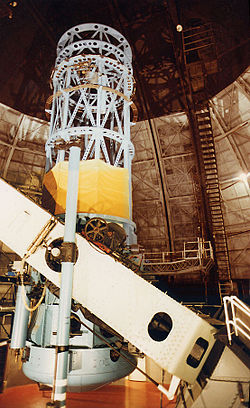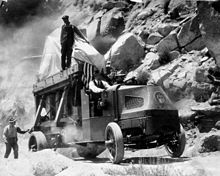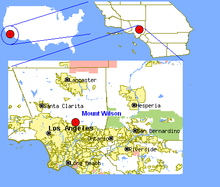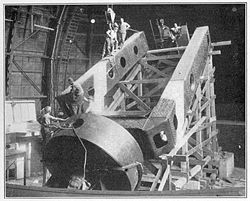- Mount Wilson Observatory
-
Mount Wilson Observatory 
The 100-inch (2,500 mm) Hooker telescope that Edwin Hubble used to discover the general expansion of the universeOrganization Mount Wilson Institute Code 672 Location Mount Wilson, Los Angeles County, California CoordinatesAltitude 1,742 m (5,715 ft) Website
http://www.mtwilson.eduTelescopes60" Telescope 60" reflector Hooker Telescope 100" reflector Infrared Spatial Interferometer 3 65" reflectors CHARA array 6 40" reflectors The Mount Wilson Observatory (MWO) is an astronomical observatory in Los Angeles County, California, United States. The MWO is located on Mount Wilson, a 5,715 foot (1,742 m) peak in the San Gabriel Mountains near Pasadena, northeast of Los Angeles. The observatory contains two historically important telescopes: the 60 inch (1.5 m) Hale telescope built in 1908, and the 100 inch (2.5 m) Hooker telescope, which was the largest telescope in the world from its completion in 1917 until 1948.
Thanks to the inversion layer that traps smog over Los Angeles, Mount Wilson has naturally steadier air than any other location in North America, making it ideal for astronomy and in particular for interferometry.[1] The increasing light pollution due to the growth of greater Los Angeles has limited the ability of the observatory to engage in deep space astronomy, but it remains a productive center, with many new and old instruments in use for astronomical research.
The observatory was conceived and founded by George Ellery Hale, who had built the 40 inch (1 m) telescope at the Yerkes Observatory. The Mount Wilson Solar Observatory was first funded by the Carnegie Institution of Washington in 1904, leasing the land from the owners of the Mount Wilson Hotel in 1904. Among the conditions of the lease was that it allow public access.[2]
Contents
60 inch (1.5 m) Telescope
George Ellery Hale received the 60 inch (1.5 m) mirror blank, cast by Saint-Gobain in France, in 1896 as a gift from his father, William Hale. It was a glass disk 7½ inches (191 mm) thick and weighing 1900 pounds (860 kg). However it was not until 1904 that Hale received funding from the Carnegie Institution to build an observatory. Grinding began in 1905 and took two years. The mounting and structure for the telescope was built in San Francisco and barely survived the 1906 earthquake. Transporting the pieces to the top of Mount Wilson was an enormous task. "First light" was December 8, 1908. It was at the time the largest operational telescope in the world.[1]
The 60 inch reflector became one of the most productive and successful telescopes in astronomical history. Its design and light-gathering power allowed the pioneering of spectroscopic analysis, parallax measurements, nebula photography, and photometric photography. Though surpassed in size by the Hooker telescope nine years later, the Hale telescope remained one of the largest in use for decades.
In 1992, the 60 inch telescope was fitted with an early adaptive optics system, the Atmospheric Compensation Experiment (ACE). The 69-channel system improved the potential resolving power of the telescope from 0.5-1.0 arc sec to 0.07 arc sec. ACE was developed by DARPA for the Strategic Defense Initiative system, and the National Science Foundation funded the civilian conversion.
Today, the 60 inch telescope is used for public outreach. Eyepieces are fitted to its focus instead of instruments. It is the largest telescope in the world devoted to the general public. As of June 2009, the cost for a half-night of observation is $900, $1700 for a full night.
100 inch (2.5 m) Hooker Telescope
 The 100-inch (2,500 mm) mirror on its way up the Mount Wilson Toll Road on a Mack Truck in 1917.
The 100-inch (2,500 mm) mirror on its way up the Mount Wilson Toll Road on a Mack Truck in 1917.
Hale immediately set about creating a larger telescope. John D. Hooker provided crucial funding for it, along with Carnegie.[3] The Saint-Gobain factory was again chosen to cast a blank in 1906, which it completed in 1908, After considerable trouble over the blank (and potential replacements), the 100 inch (2.5 m) telescope was completed and saw "first light" on November 2, 1917. The blank started with over two tons of fused glass which was melted in a furnace into one piece. The blank once melted into one piece took over a year to cool without cracking. [4]
Just like the 60" telescope, the mechanism incorporates a mercury float to provide smooth operation. The Hooker telescope was equipped in 1919 with a special attachment, an optical astronomical interferometer developed by Albert Michelson, much larger than the one he had used to measure Jupiter's satellites. Michelson was able to use the equipment to determine the precise diameter of stars, such as Betelgeuse, the first time the size of a star had ever been measured. Henry Norris Russell developed his star classification system based on observations using the Hooker.
In 1935 the silver coating used since 1917 on the Hooker 100 inch mirror was replaced with a more modern and longer lasting aluminum metallic coating that reflected 50% more light than the older silver method of coating. The newer method of coating for the telescope mirrors was first tested on the older 60 inch mirror telescope.[5]
Edwin Hubble performed his critical calculations from work on the 100 inch (2.5 m) telescope. He determined that some nebulae were actually galaxies outside our own Milky Way. Hubble, assisted by Milton L. Humason, discovered the presence of the redshift that indicated the universe is expanding.[1]
The Hooker's reign of three decades as the largest telescope came to an end when the Caltech-Carnegie consortium completed its 200-inch (5.1 m) telescope in 1948 at Palomar Observatory, 90 miles (150 km) south, in San Diego County, California.
By the 1980s, the focus of astronomy research had turned to deep space observation, which required darker skies than what could be found in the Los Angeles area, due to ever-increasing problem of light pollution. In 1986, the Carnegie Institution, which ran the observatory, handed it over to the non-profit Mount Wilson Institute. At that time, the 100 inch (2.5 m) telescope was deactivated, but it was restarted in 1992 and outfitted with adaptive optics. The Hooker telescope remains one of the pre-eminent scientific instruments of the 20th century.
The telescope has a resolving power of 0.05 arcsecond.
Solar telescopes
There are three solar telescopes, two of which are now used for astronomical research, also known as solar towers due to their construction. The 60 foot (18 m) tower telescope was completed in 1908, and the 150 foot (46 m) tower telescope was completed in 1912. The Snow solar telescope, built in 1904 is used for educational demonstrations. The telescopes are used to study helioseismology and other changes in the sun's nature.
Interferometry
The extremely steady air over Mount Wilson is well suited to interferometry, the use of multiple viewing points to increase resolution enough to allow for the direct measurement of the size of details such as star diameters. Michelson performed the first measurements of other stars in the history of astronomical interferometry on the Hooker telescope in 1919.
The Infrared Spatial Interferometer (ISI) is an array of three 65 inch (1.65 m) telescopes operating in the mid-infrared. The telescopes are fully mobile and their current site on Mount Wilson allows for placements as far as 70 m apart, giving the resolution of a telescope of that diameter. The signals are converted to radio frequencies through heterodyne circuits and then combined electronically using techniques copied from radio astronomy. ISI is run by an arm of the University of California, Berkeley. The longest (70m) baseline provides a resolution of 0.003 arcsec at 11 micrometers. On July 9, 2003, ISI recorded the first closure phase aperture synthesis measurements in the mid infrared.
The Center for High Angular Resolution Astronomy (CHARA) array is an interferometer formed from six 1 m (40-inch) telescopes arranged along three axes with a maximum separation length of 330 m. The light beams travel through vacuum tubes and are combined optically, requiring a building 100 meters long with movable mirrors to keep the light in phase as the earth rotates. CHARA is operated by the Georgia State University and began scientific use in 2002 and began "routine operations" in early 2004. In infrared the integrated image can resolve down to 0.0005 arcseconds. As of 2005, four of the six telescopes have been commissioned for interferometric observations.
These and other astronomical interferometers are included in the List of astronomical interferometers at visible and infrared wavelengths. The history of the development of these instruments is given in History of astronomical interferometry.
Other telescopes
A 24-inch (610 mm) telescope fitted with an infrared detector purchased from a military contractor was used by Eric Becklin in 1966 to determine the center of the Milky Way for the first time.[6]
In 1968, the first large-area near-IR (2.2 µm) survey of the sky was conducted by Gerry Neugebauer and Robert B. Leighton using a 62-inch (1.6 m) reflecting dish they had built.[7] The instrument is now in the Smithsonian.[8]
History
- Letters to the Mount Wilson Observatory are the subject of a permanent exhibition at the Museum of Jurassic Technology in Los Angeles, California. A small room is dedicated to a collection of unusual letters and theories received by the observatory circa 1915–1935. These letters were also collected in the book No One May Ever Have the Same Knowledge Again: Letters to Mt. Wilson Observatory 1915–1935 (ISBN 0-9647215-0-3).
- The historic monument came under threat during the August 2009 California wildfires.[9]
- The poet Alfred Noyes was present for the "first light" of the Hooker telescope on November 2, 1917. Noyes used this night as the setting in the opening of Watchers of the Sky, the first volume in his trilogy The Torchbearers, an epic poem about the history of science. According to his account of the night, the first object viewed in the telescope was Jupiter and Noyes himself was the first to see one of the planet's moons through the telescope.[10]
See also
- Mount Wilson Toll Road
- Hale Telescope
- List of largest optical reflecting telescopes
- List of largest optical telescopes historically
- List of largest optical telescopes in the 20th century
References
- ^ a b c Hansen, Wendy (July 6, 2008). "Mount Wilson Observatory an astronomical gem". Los Angeles Times. http://www.latimes.com/news/local/la-me-then6-2008jul06,0,6407442.story. Retrieved 2008-07-06.
- ^ Window to other worlds - SGVTribune.com
- ^ History of Mount Wilson Observatory - Building the 100-Inch Telescope. Article written by Mike Simmons in 1984 for the Mount Wilson Observatory Association (MWOA).
Hooker's gift [$45,000] would cover only one tenth of the total cost [...] In 1911, Andrew Carnegie became a sympathetic benefactor to George Ellery Hale, who was trying to build the 100 inch (2.5 m) Hooker telescope at Mount Wilson, and donated an additional ten million dollars to the Carnegie Institution with the following suggestion to speed up the construction of the now historically famous telescope: "I hope the work at Mount Wilson will be vigorously pushed, because I am so anxious to hear the expected results from it. I should like to be satisfied before I depart, that we are going to repay to the old land some part of the debt we owe them by revealing more clearly than ever to them the new heavens." The telescope saw successful first light on November 2, 1917, Carnegie still alive. - ^ "Frozen Eye to Bring New Worlds into View" Popular Mechanics, June 1931 see left column of article
- ^ "Aluminum-Coated Mirrors Boost Power of Giant Telescope" July 1935 Popular Science Monthly
- ^ "Monster of the Milky Way", NOVA PBS Airdate: October 31, 2006 [1]
- ^ http://www.astro.psu.edu/users/kluhman/a597/Lec3.pdf
- ^ http://pr.caltech.edu/periodicals/caltechnews/articles/v40/infrarednecks.html"Infrarednecks: How Three Caltech Alumni Helped Take Infrared Astronomy from the Farm to the Major Leagues" Michael Rogers, Caltech News Volume 40, number 2
- ^ Mozingo, Joe (August 30, 2009). Station fire likely to hit historic Mt. Wilson observatory, fire officials say. Los Angeles Times
- ^ Noyes, Alfred (1922). Watchers of the Sky.
External links
Categories:- Astronomical observatories in California
- Landmarks in Los Angeles, California
- History of Pasadena, California
- San Gabriel Mountains
- Domes
- Buildings and structures in Los Angeles County, California
Wikimedia Foundation. 2010.


